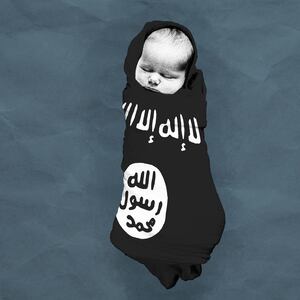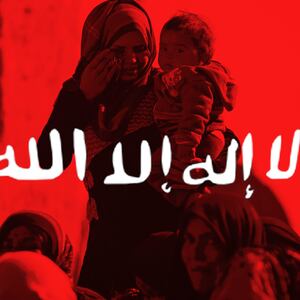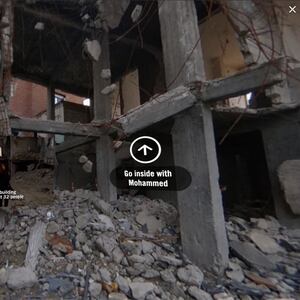Their images are by now well known: the thousands of women and children who emerged from ISIS’s last stronghold, now housed in the al Hol detention camp in Northwest Syria. According to Kurdish forces, these are the wives and children of foreign fighters, and their future hangs in the balance.
Yet out of the town of al Baghouz from which they staggered—a town which the U.S.-led Coalition effectively destroyed—also came an estimated 60,000 Iraqi and Syrian women and children, survivors of the last battle of a five year air and ground campaign to obliterate the so-called Islamic State as a territorial entity.
Many questions about that battle still need answers, including why the Coalition continued to employ its massive firepower on an increasingly narrow swath of territory in the Middle Euphrates River Valley, or MERV? And why, after five years of fighting, were military planners so completely wrong-footed in their estimates of the huge civilian population still left inside Baghouz, the final redoubt of ISIS?
The Coalition’s own data illustrates the bombardment's intensity. Over a four month period, ISIS was pushed by air and artillery strikes out of a string of towns and villages—including Hajin, Kashma and al Soussa—and driven relentlessly south towards the hard line of the Iraq border at Baghouz.
Between December 16 and March 9, CJTF-OIR reported a total of 2,151 separate strikes on ISIS targets in Syria. Tracking the location of Coalition bombings has become more difficult after it stopped identifying the nearest city or town in late 2018. With the MERV the only area of Syria where Coalition-backed forces were still involved in large scale hostilities—and the only place where Airwars recorded substantial allegations of civilian harm—it’s safe to assume that the great majority of those 2,151 strikes targeted the zone. The effects were profound.
Josh Lyons, director of geospatial analysis at Human Rights Watch, has studied satellite imagery charting the path of destruction etched into the Syrian landscape by Coalition strikes along a stretch of land connecting Hajin—where ISIS was defeated in December—down to Baghouz and the Iraqi border. Though the Coalition refrained from creating a “Highway of Death,” by blasting every retreating vehicle off the road, the damage was nevertheless astonishing. In many places, seemingly every other building was destroyed and thousands of structures, in Lyon’s estimation, appear to have been bombed into ruin in recent sorties.
“When we look at the waves of destruction, and look at the actual number of people who survived, the larger question is how many people didn’t make it out,” said Lyons. “There needs to be an authoritative independent investigation to determine casualties.”
In response to Airwars questions about whether the Coalition’s strikes in the final months of the campaign had been focused on pushing ISIS to the Iraqi border versus destroying them en route—and whether this related to attempts to prevent civilian harm—spokesperson Col. Scott Rawlinson insisted that “a majority of the strikes conducted were isolated to eliminate Daesh [ISIS] identified by intelligence at remote locations.”
Airwars’ earlier probes, including assessments of the battles for Mosul and Raqqa, indicate that levels of civilian harm in the anti-ISIS war often tracked closely with the intensity of bombardment, along with any significant presence of civilians. Other findings suggest this trend is only worsened by intelligence failures. So did the same happen at Baghouz?
The Coalition, again breaking with past practice, will no longer provide Airwars with munition figures for the final months of fighting in the MERV. However continued heavy use of artillery and aerial firepower is readily apparent in satellite imagery of eastern Syria, and equally from witness accounts on the ground. There are also clues from Coalition members. Speaking to the AFP news agency as fighting in Baghouz began, French artillery commander Col. François-Régis Legrier said that his forces alone had fired some 3,500 rounds in the previous four months.
Legrier also took the extraordinary step of publishing an excoriating critique of the Coalition’s own tactics in eastern Syria—ones his forces helped carry out—which he described as wantonly destructive. The article in Revue Défense Nationale, which has since been removed from its website, and with Legrier reportedly facing reprimand from French authorities—focused primarily on the battle for Hajin. The French artillery colonel claimed the town could have been captured with less prolonged suffering if ground forces had played a more prominent role.
“We have massively destroyed the infrastructure and given the population a loathsome image of what a Western-style liberation may be like, leaving behind the seeds for an imminent resurgence of a new adversary,” wrote Legrier.
Reporters on the ground found evidence of where those artillery shells had fallen, and also where predominantly American aircraft had unloaded their quarter-ton bombs from the air.
“I did notice on the approach to Baghouz, in towns such as Soussa and Hajin… there were much deeper and larger craters than I’d seen in Mosul,” said Josie Ensor, Middle East Correspondent for the Daily Telegraph, who also covered earlier battles against ISIS in both Iraq and Syria. “They were about 2-3 storeys deep, which suggested to me the Coalition might have been using 500 lb Paveway IV bombs to just destroy everything moving in those towns.”
No one doubts that the majority of those trapped at Baghouz at the end were civilians who, like the ISIS fighters alongside them, now had nowhere left to flee. Whether that was always the Coalition’s intent is less clear.
“The question of whether civilians were pushed into Baghouz is a tricky one because there were different dynamics at play,” said Nadim Houry, a senior researcher with Human Rights Watch, who spoke with people who fled the fighting. “On the one hand, some people were able to escape to SDF-held areas and avoid being trapped in Baghouz. But others told us that they were too scared and felt they had no choice but to move with ISIS until there was nowhere to retreat to.”
As fighting for Baghouz intensified in early February, videos showed bombs hitting all around the small area where civilians and fighters were sheltering, at times appearing to hit munitions depots. Two weeks into the fighting, Human Rights Watch documented what appeared to be ongoing mass burials in Baghouz. “Escaped civilians told us bodies were piling up in the streets by the end,” tweeted Washington Post reporter Louisa Loveluck.
SDF officials repeatedly suggested victory was close at hand, and that few fighters and civilians remained either in a warren of tunnels beneath Baghouz, or in surface encampments strewn with tents and vehicles that served as the backdrop for press reports—both of which were targeted by Coalition air and artillery strikes.
Yet the alliance’s intelligence proved completely wrong. Thousands upon thousands of women and children—and hundreds of ISIS fighters—continued to pour out of the town during pauses in hostilities.
“During the battle for Baghouz, SDF spokesmen and officials continuously expressed their surprise at the number of people,” said Hashem Osseiran, a journalist with AFP who managed the agency’s coverage from Beirut. “The large number of people still inside Baghouz was also a surprise for us journalists, who were struggling to understand how so many people could be living in what is essentially a small patch of land the size of a few football pitches.”
Meanwhile, a Western journalist who arrived at the front on March 1 described the tempo of fire inside the town: “I saw two airstrikes and felt another two in the space of about two hours,” said the reporter, who works for a large Western outlet but asked not to be named. “That is much more intense than anything I saw in Raqqa, especially when you take into consideration that the pocket in Baghouz was so small. I left the front that first night convinced nothing could possibly have survived that barrage.”
By the second week of March, those emerging from the town told reporters “about bodies, body parts in the streets of women and children.” Reporting at night, as Coalition strikes in the near-distance hit parts of the town where women and children likely still sheltered, CNN’s Ben Wedeman said, “There have probably been a very high number of civilian casualties, fatalities as a result of the ferocity of the airstrikes, the artillery, the mortars as well as the heavy machine gun fire.”
Meanwhile, aid groups expressed alarm at the number of women and children fleeing the last redoubt of ISIS. The U.N., too, appeared to be caught unaware. On February 19, its human rights office expressed concern for around 200 families it said were in the last slivers of ISIS-controlled areas. There were in fact many, many more. For those on the ground, visibility may have been limited, but shouldn’t the Coalition have known better?
“During the planning phase, it is incumbent on the military to undertake assessments on the terrain… location of infrastructure and religious sites, estimates on population and density, [and] population pattern of life,” said Sahr Muhammedally, Middle East and North Africa director at CIVIC. “We learned a lot on challenges in fighting in cities like Mosul and Raqqa. One would hope the Coalition integrated key lessons from those battles in order to reduce civilian harm."
Yet during the roughly three month period which included the final battle in Baghouz, the Coalition reported bombing on average 54 targets every day, only just below the 56 targets bombed per day in Mosul during March 2017—a month which had seen the most intense Coalition bombardment of that city, and the highest reported civilian casualties.
Based on satellite imagery, HRW reported that “the majority of buildings in Baghouz were destroyed”—the group counted “630 major damage sites”—“during a one-month period between January 19 and February 20, a period during which large numbers of civilians were still present.” During the month and a half battle for the town, the Coalition reported that over 1,600 targets were struck in Syria by its forces—again, nearly all likely in Baghouz.
“The planes were hitting people even as they escaped—we saw them one night, up on the mountain people trying to escape, women and children and then boom, boom—two rockets right on the mountain,” said one Iraqi man who spoke with HRW.
The true civilian death toll in Baghouz remains unknown. Airwars’ current best estimate of between 326 and 850 civilians killed—based on available reporting of likely civilian deaths from December 1 to March 21— may be outweighed by the ultimate total in Baghouz alone. In a single event on March 19, for example, at least 160 civilians reportedly died, according to multiple sources.
“I have no way to ascertain how many people died,” said one aid official who recently visited a camp for survivors. Those who spoke to Ensor, the Telegraph correspondent “talked about seeing piled up bodies” in Baghouz. The main encampment in the town was off limits in the final days of fighting, she said, which some surmised was “because the clean-up of bodies had been going on.”
Others offer a contrary perspective, with one Western reporter telling Airwars: “I think, actually, miraculously, most women and children got out alive. I think being in tunnels saved most of them. Most were suffering from malnutrition and cold rather than injury. [Al Hol] camp authorities said there was only an uptick in people arriving with trauma wounds in the last week of the offensive. No one I spoke to of dozens of women who came out mentioned that their children or friends had died in airstrikes.“
Most of the women and children who emerged from Baghouz were sent north by the SDF to a camp for displaced persons called al Hol, in Hasakah governorate. From a population of some 10,000 in December, al Hol swelled to house 45,000 by the end of February. The camp currently holds at least 73,000 women and children, as international agencies warn of dire conditions within.
But was everyone in Baghouz associated with ISIS? According to recent accounts, some of the foreign women have had to be separated from their Iraqi and Syrian counterparts at al Hol, “many of whom fled the Islamic State,” as The Washington Post reported.
Formerly enslaved Yazidi women who escaped Baghouz were also brought to al Hol, said ICRC President Peter Mauer, who visited the camp in March. “Because they can't prove who they [the women] are they are basically put in detention-like facility in camps,” he told a group of reporters in New York earlier this month.
That so many were able to escape Baghouz was due primarily to the Syrian Democratic Forces, the Coalition’s Kurdish-dominated proxies in eastern Syria. SDF-orchestrated pauses in the battle allowed tens of thousands to escape.
“The SDF paused fighting multiple times to allow civilians an opportunity to get out of harm's way,” Coalition spokesperson Col. Scott Rawlinson told Airwars. “They were extraordinarily good stewards of their duty to protect civilians from danger and conducted their engagements professionally and responsibly.”
Dareen Khalifa, senior analyst at the International Crisis Group, recently travelled to eastern Syria and spoke with the SDF leadership. These high-ranking officials, she said, couldn’t give a clear answer on why intelligence was so poor. Khalifa did get the impression, however, that the SDF was—possibly to a greater extent than the Coalition due to local considerations—more cautious in their tactics.
“This has always been a strategic decision from the SDF, especially in the final battles,” said Khalifa. “There was a lot of back and forth between them and the Coalition, but they were very consistent on not wanting to get dragged into what was going to be a massacre with large civilian casualties,” she said.
It may be a long wait before the real toll for civilians and ISIS fighters at Baghouz is understood. As time passes, it becomes more difficult to piece together individual stories, or determine where someone was killed in the final months of fighting. Almost two years after the Coalition and its allies defeated ISIS at Mosul and Raqqa, the alliance has expressed no appetite for any official inquiry into the thousands of civilians credibly reported killed in those cities.










